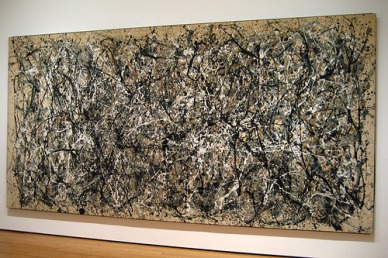Abstract Art
· Three art movements which contributed to the development of abstract art were Romanticism, Impressionism and Expressionism. Artistic independence for artists was advanced during the 19th century. Patronage from the church diminished and private patronage from the public became more capable of providing a livelihood for artists.
· During the Nazi rise to power in the 1930s many artists fled from Europe to the United States. By the early 1940s the main movements in modern art, expressionism, cubism, abstraction, surrealism, were represented in New York: Marcel Duchamp, Fernand Léger, Piet Mondrian, Jacques Lipchitz, Max Ernst, André Breton, were just a few of the exiled Europeans who arrived in New York. The rich cultural influences brought by the European artists were built upon by local New York painters. The climate of freedom in New York allowed all of these influences to flourish. The art galleries that primarily had focused on European art began to notice the local art community and the work of younger American artists who had begun to mature. Certain of these artists became distinctly abstract in their mature work.The best known group of American artists became known as the Abstract expressionists. In New York City there was an atmosphere which encouraged discussion and there was new opportunity for learning and growing. The expressionistic gesture and the act of painting itself, became of primary importance to Jackson Pollock and Franz Kline. While during the 1940s Arshile Gorky's and Willem de Kooning's figurative work evolved into abstraction by the end of the decade. New York City became the center, and artists worldwide gravitated towards it; from other places in America as well.
· During the Nazi rise to power in the 1930s many artists fled from Europe to the United States. By the early 1940s the main movements in modern art, expressionism, cubism, abstraction, surrealism, were represented in New York: Marcel Duchamp, Fernand Léger, Piet Mondrian, Jacques Lipchitz, Max Ernst, André Breton, were just a few of the exiled Europeans who arrived in New York. The rich cultural influences brought by the European artists were built upon by local New York painters. The climate of freedom in New York allowed all of these influences to flourish. The art galleries that primarily had focused on European art began to notice the local art community and the work of younger American artists who had begun to mature. Certain of these artists became distinctly abstract in their mature work.The best known group of American artists became known as the Abstract expressionists. In New York City there was an atmosphere which encouraged discussion and there was new opportunity for learning and growing. The expressionistic gesture and the act of painting itself, became of primary importance to Jackson Pollock and Franz Kline. While during the 1940s Arshile Gorky's and Willem de Kooning's figurative work evolved into abstraction by the end of the decade. New York City became the center, and artists worldwide gravitated towards it; from other places in America as well.
Nocturne in Black and Gold: The Falling Rocket.
Painted by James Abbott McNeill Whistler.

Early intimations of a new art had been made by James McNeill Whistler who, in his painting Nocturne in Black and Gold: The falling Rocket, (1872), placed greater emphasis on visual sensation than the depiction of objects. This painting depicts a fireworks show in the night sky over Battersea Bridge in an industrial London city park. The gold flecks and splatters represent the exploded fireworks in the night sky. The fireworks light up the sky, producing a glow in the thick air and billowing smoke. The artist was more interested in conveying atmospheric effects than he was in providing details of the actual scene. The painting was controversial. There is a sense of spatial ambiguity set against a structure of line and form. The contradictory qualities of energy and stillness are combined here.
Paul Jackson Pollock

http://farm2.static.flickr.com/1220/564040776_2c3d967e38.jpg
Paul Jackson Pollock (January 28, 1912 – August 11, 1956) was an influential American painter and a major figure in the abstract expressionist movement, who is best known for his ‘splatter paint’ artwork. In fact, his most impressive painting is titled “One: November 31, 1950”(see left). This was Jackson Pollack’s first (documented) and most impressive piece of artwork. The size of this took up one entire wall at the MOMA, and if you look closely you can see how much effort was actually put into making these simple-looking paint splatters. Many people might think to themselves-“oh wow all he did was splatter some paint on a canvas and made tons of money, I could do that!” but the thing about Pollack’s work was that he wasn’t original. Pollack was one of the first painters to think outside of the box and do something so completely odd that nobody would ever think of doing before. Sure, you can try to splatter paint and make it look like a masterpiece like Pollack, but you wouldn’t be new, and original. The public wouldn’t care much about your works because it wasn’t something that was being tried for the first time. Another thing that Pollack really had understood was the way to put colors together so that they contrasted and corresponded very well with each other at the same time. Pollack was an art genius and made a breakthrough with his art work, in my mind.
